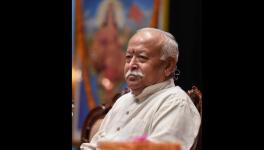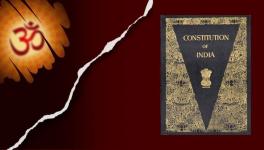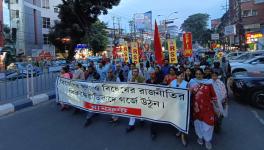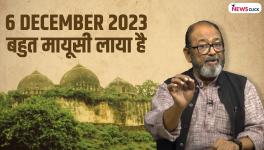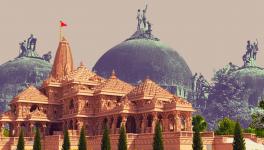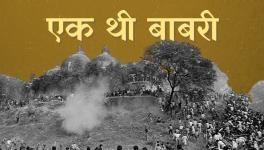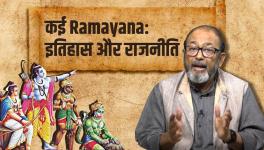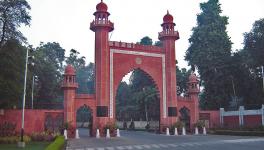Ayodhya: An Apprehensive City Faces Its Darkest Fears
Not just Ayodhya, the whole country is awaiting the decision on the Babri Masjid dispute. Even when a petition was filed to construct a Ram temple in 1883 and when the idol was placed inside the mosque in 1949, nobody would have thought that this small plot of land in Muhalla Ramkot would turn into today’s longstanding Ayodhya dispute.
Now the whole country will be out of breath, wondering what will ensue after the Supreme Court announces its decision next month. The situation is similar to 2010, when 60 years after the idol was placed, the Lucknow bench of the Allahabad High Court delivered its verdict. The whole country seemed to have stopped dead in its tracks. The police and administration were extremely nervous. After the verdict, everyone breathed a sigh of relief. At first, no one understood who won and who lost.
The High Court had distributed the land to all three major parties to the dispute, a relief which none of the parties had sought from the court. Among them, two major parties were of Hindus, the Nirmohi Akhara and Ramlalla Virajman. The maim Muslim party was the Sunni Central Waqf Board. No party was satisfied with the High Court’s decision, although it did not bring any crisis, communal tension or violence in its wake. All the parties reached the Supreme Court against this decision in 2011 itself and after a 40-day hearing in 2019, now the final decision on it has to be taken.
Dozens of attempts were made to thrash out a settlement outside the court but none of them worked. Now, more than the decision on the Ramjanmabhoomi-Babri Masjid dispute itself, all kinds of apprehensions are forming in the minds of the people about the fallout of the Supreme Court’s verdict.
The people of Ayodhya have witnessed long periods of upheavals, violence and anarchy between 1984 and 1992 over this dispute. Therefore, their apprehensions are natural. People feel that a curfew will definitely be imposed, and so they are arranging for rations. Bunkers are being built on the routes leading to the disputed site. Due to this, the sants, mahants and householders alike, who live in those areas, are facing trouble. Access to shortcuts has been stopped. Ayodhya is already divided into three zones in terms of security. The residents of Ayodhya-Faizabad now feel that they will have to live under tight security restrictions like in Kashmir in coming days. Even if the situation does not come to that.
Now a Deepawali fair has also been included in the three fairs that are held in Ayodhya. Uttar Pradesh Chief Minister Adityanath’s government has been officially celebrating Diwali in the city for the past three years. In the name of tourism, it has been enhancing the status of the arrival of Ram in Ayodhya after his exile and victory over Lanka.
This year, the Deepawali fair was a five-day event, in which Tretayuga was staged through a laser show using modern knowledge, science and technology. The Chief Minister and a Union minister received artistes playing Ram and Sita, who landed from their ‘pushpaka vimana’ (helicopter) at the site of the celebrations. The Chief Minister and the state Governor performed their aarti and other religious rituals. A light and sound programme created a festive scene on the banks of the river Sarayu.
Before the Yogi government assumed power, no special festival was held to mark Rama’s “Ayodhya Wapasi” or return to Ayodhya. The Diwali festival was limited to kheel, batashey, laiya and worship of Ganesh-Lakshmi and darshan at temples. After the High Court’s decision in 2010, the question arose, how is the Diwali of Ayodhya? Very few people come visiting Ayodhya during Diwali and so no special programme used to be held in the city at this time. Millions of devotees throng to the Shravan Mela, Chaitra Ramnavami fair and Karthik Parikrama fair.
Adityanath’s government officially declared the festival on Deepotsav 2019. An official attempt was made to set up a grand programme at Ram Ki Paidi on the banks of the Sarayu river, before the hearings of the Ayodhya dispute were over and before the verdict was announced. All the saints and monks from the Vishwa Hindu Parishad (VHP) hope that the Ram temple is going to be built, so there is no sign of tension on their faces. Prior to the decision, the VHP had stopped all programmes of its organisation in Ayodhya.
Yet, this year the Adityanath government has set a new record of burning lamps simultaneously in the Guinness Book, breaking its own record of last year. Rs133 crore are estimated to have been spent on this Diwali festival. All the departments and the entire state machinery were engaged in these preparations. The Municipal Corporation of Ayodhya also distributed hundreds of lamps, wicks and oil in dalit neighbourhoods. The government claims that six lakh lamps were lit all over Ayodhya.
The Ramjanmabhoomi-Babri Masjid dispute is so complicated that everyone’s eyes are on the reaction that follows the verdict. The general public is apprehensive, the people of Ayodhya have seen and endured a lot in the last decades. Therefore, their apprehension is natural.
Most Ayodhya residents and members of the VHP feel that the decision will be in favour of the temple, so there will not be much of a problem. The people on the other side say that if the decision is settled once and for all, they will be rid of the hassles it has wrought on them.
In view of the impending verdict, the security of all the parties involved in the Ayodhya dispute has been made so stringent that it is now mandatory to register ones name in a diary before meeting them. A photo will be taken with a mobile camera of all visitors. If the party to the dispute wants to meet a person, only then will they be permitted to meet. There is a strong cordon of security outside and around their homes making it difficult to meet even easily accessible people. Be it mahant Nritya Gopal Das of Ramjanmabhoomi Nyas or Iqbal Ansari, a Muslim party. Iqbal Ansari says, “Let the decision arrive; then we can move on to something else.”
Ashok Singh, who is associated with the Gokul Bhawan in Ayodhya and lives in Faizabad city says, “I have come to the village to arrange supplies for my house. If curfew is imposed, there should be rations at home. Ayodhya was peaceful for a long time [but] now it seems like something will happen.”
There was a time when Paramhans Ramchandra Das and Mudai Hashim Ansari, appellants for the Ram Janmabhoomi and Babri Masjid, respectively, used to go to court together. Now the situation is that an alleged shooter visits his son Iqbal Ansari at his home, gets into a conflict with him and then goes to court to file a case against him. To get popular in the media, a restless mahant arrives at his house and says he will read the Hanuman Chalisa there; so Iqbal Ansari says, read—‘who is stopping you?’
This dispute of Ayodhya has not changed the axis of the country’s politics, it has changed the fabric of the entire society. The new generation has not seen the bite, so they are unaware of that pain and anguish. Since 1989, the politics of the country has been revolving around this dispute, whether unintended or not, directly or indirectly. The Bharatiya Janata Party (BJP), which won two seats in Parliament in 1984-85, flourished as a result of the Ayodhya controversy.
The BJP is ruling at the Centre and it has an absolute majority in Uttar Pradesh. The BJP and its maternal and ancillary organisations gradually entered this dispute through the Ramjanaki Rath Yatra in 1984, followed by the agitation demanding unlocking its gates in 1985-86, the laying of the foundation stone on the disputed land in 1989 and then, in the name of kar seva, the attempt to break the Babri Masjid, the firing that took place and then a mob called by it demolished the mosque in broad daylight in 1992. Now such a party is ruling at the Centre and the state. On December 6,1992, twelve Muslims lost their lives, 267 shops and houses were burnt in the violence of kar sevaks in Ayodhya.
According to the records so far, the trial started by mahant Raghuvaradas in 1883 to build a temple on ramchabootara in order to save Ramlalla from the cold, sun and heat in the 19th century. This neither got permission from the lower court nor in the appeal of Awadh Chief Court. The matter was over almost before it began.
After the first Independence struggle of 1857 was unsuccessful, with the merger of Awadh with the British Raj, the courtyard of the mosque was divided into the shape of the letter “L” of the English alphabet. In the wall that was built, iron-grilled windows and two doors were installed so that people could enter the mosque.
After the partition of the courtyard, one portion was called the “inner courtyard” where the statues were forcibly installed on December 22-23 ,1949. The outer part, where there was “Ramlalla” at one door and “Sita’s rasoi” or a Chati-worship place at the other door, was called the “outer courtyard”. Prayers continued to be offered here, and after the idol was kept, the statues placed within the dome also started to be worshiped by court order. Thus, the nature of this place itself changed.
The Nirmohi Akhara says it was allowed to worship on the platform inside the mosque during the rule of Akbar, but no concrete evidence is available to support this claim. At the same time, Sunni Central Waqf Board has also been claiming a grant from Babar, of which there are no original documents either.
According to the FIR written in Ayodhya Kotwali on December 22-23, 1949, the idol was kept forcibly inside the mosque and when those who placed the idol were prosecuted, the charge sheet said that “these people thought it was an old temple and hence had kept the idol inside”.
The matter was transferred from the court of Faizabad to the High Court, on the specific request of the government, due to which, instead of any decision from the lower court, it was directly referred to the Lucknow Special Bench of the Allahabad High Court. The High Court conducted day-to-day hearings into the matter and gave its decision on September 30, 2010. In this decision, the three major parties to the dispute were ordered to give one-third of the disputed land each. None of the parties were satisfied with the decision and went to the Supreme Court.
The Babri Masjid-Ramjanmabhoomi lawsuit was originally a land dispute but its religious nature also became after the temple was added to the point of debate: “Was there a temple here” then became a question in this dispute. At the same time, the dispute started to be seen from the perspective of the impact it has on society as a whole. Whatever be the decision in this case, not all sides can win—one side will have to lose.
As the verdict looms, a section of Muslim intellectuals have said that whatever the court’s decision may be, it is not possible to build a mosque at that place, so it is better the Sunni Central Waqf Board hands it over to the government. Zamir-ud-din Shah, the former Vice-Chancellor of Aligarh Muslim University, under the banner of Muslim Initiative for Peace Institute, has said, “We have been fighting for 40 years but what has been achieved. After the verdict, the war will start again. Even if the Muslims win, even now it will not be possible to build a mosque at that place. The hallmark of a good general is to win without fighting a war.”
If the land is handed over to the government, it will help create an atmosphere of communal harmony in the country. It is for the sake of this communal harmony that former Prime Minister PV Narasimha Rao’s government had enacted in 1993, after the demolition of the mosque, a law to acquire 67 acres of land including disputed land, which is still in the possession of the central government. However, the Muslim side does not have one opinion on this.
The Sunni Central Waqf Board (which had asked the Supreme Court to mould the relief) has given its position in a sealed envelope to the court. The decision of the Ayodhya dispute will not be just the decision of a temple or a mosque or some land. It will also write the fate of this country.
Suman Gupta is a senior journalist. The views are personal. This article was published in hindi.newsclick.in on October 28, 2019.
Get the latest reports & analysis with people's perspective on Protests, movements & deep analytical videos, discussions of the current affairs in your Telegram app. Subscribe to NewsClick's Telegram channel & get Real-Time updates on stories, as they get published on our website.










